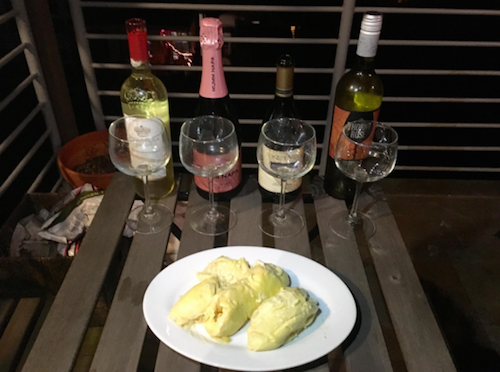Pairing Wine With Durian, Just For The Hell Of It
Can the right wine make durian better?
Photos by Ali WundermanHow the durian came to be a food that people regularly consume is a mystery I expect to never solve, but that didn’t stop me from finding the perfect wine with which to eat it.
The spiky exterior (from which the name is derived—the Malay word for “thorn” is duri) is the first indication that the whole of humankind should just stay away it. But we humans are nothing if not foolishly determined, and so at a certain point in history someone let their curiosity get the better of them, breaking open that formidable shell to explore the wonders within.
The resulting odor should have been the second indication that durian cannot be tamed. It’s a forceful stench that brutally impales the senses, eradicating any corporeal memory of life pre-durian. Some might argue that the gas-leak-in-a-decaying-corpse aroma is actually tangy and sweet, and I would argue that those people should see a series of doctors.
Yet the smell barely registers when compared to the flavor. For those who have never had the opportunity to dine upon the durian, imagine drinking gasoline that’s been flavored with rotten pineapples. It overwhelms the sinuses, conquering the nose and throat with a velvety coating that even the strongest mouthwash cannot destroy. Listerine: meet your nemesis.
Like the brave, experimental people of Southeast Asia who first came across the durian, I sensed there was more to the fruit than its unfriendly appearance, debilitating scent, and overpowering flavor, and thus commenced my quest to pair the effervescent durian with wine.

Cracking the durian-wine code is a formidable task, so I asked my friend Michelle to help out, as she is Vietnamese and grew up both eating and enjoying durian (which I’m still not convinced is possible). As an added bonus, she’s in training to be a sommelier. My fiancé Michael came along for the ride, too, bringing with him his perfect palate, adventurous appetite, and observational witticisms.
The adventure began with a trip to an Asian food market in San Francisco’s Sunset District. Frozen durian “meat,” as it’s marketed, was strategically placed at the front of the store next to the mangoes, perhaps to trick curious but naïve shoppers into buying it. They also had whole, fresh durian in stock, but I’m not enough of a masochist to keep that stinky beast hanging around my kitchen.
Next came the wine, selected based on our educated guesses about what might pair well. We took into account this 2006 blog post wherein the author suggests that sparkling rosé is the wine for durian. Michelle’s knowledge filled in the rest of the gaps, resulting in a moscato, a chardonnay, and a pinot noir added into the mix.

Initially I anticipated that I could drink all the leftover wine in a strategic attempt to forget I ever ate durian, but online research proved that wouldn’t be an option. Fervent rumors warn that the sulfur compounds found in the durian prevent the liver from properly metabolizing alcohol, causing a range of symptoms including bloating and death. Actual science, on the other hand, reaches less daunting conclusions about mixing the two, but with my wedding coming up, I just couldn’t take a chance on death by durian.